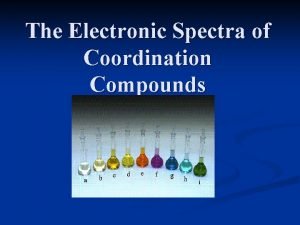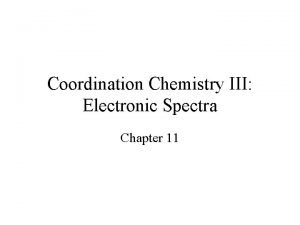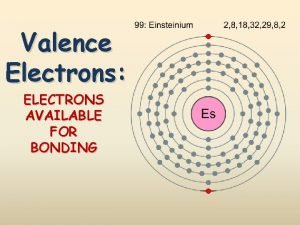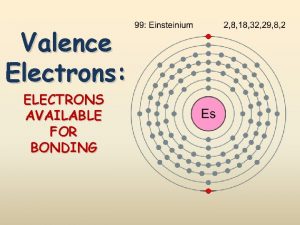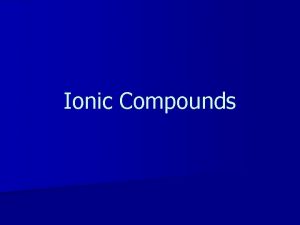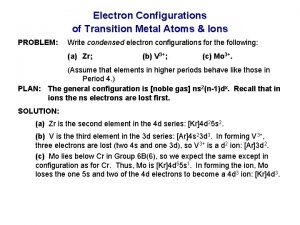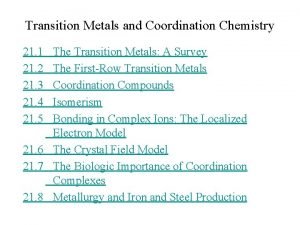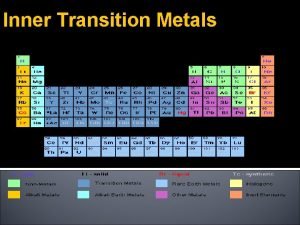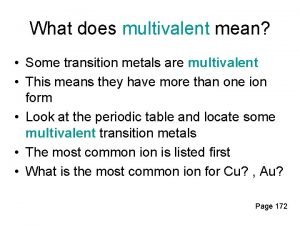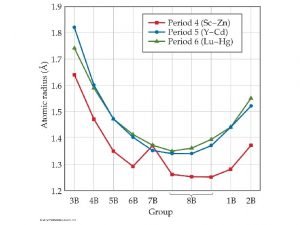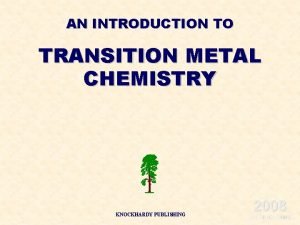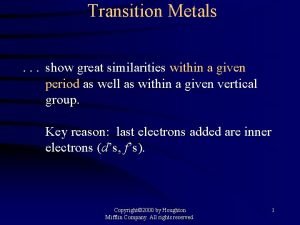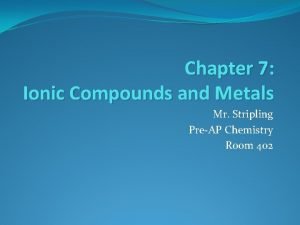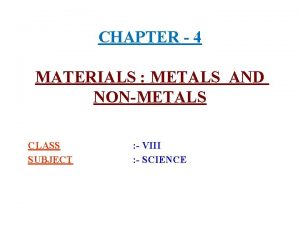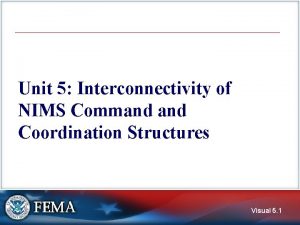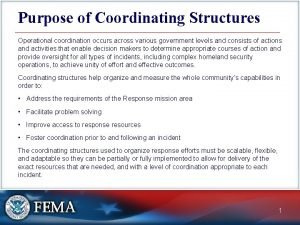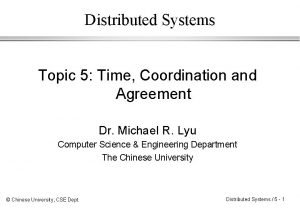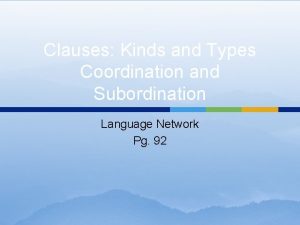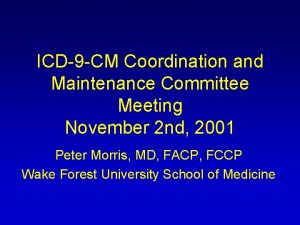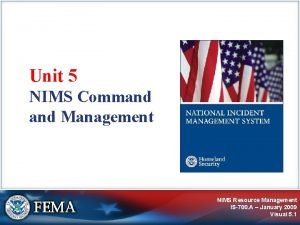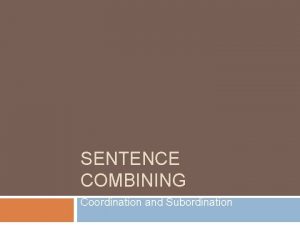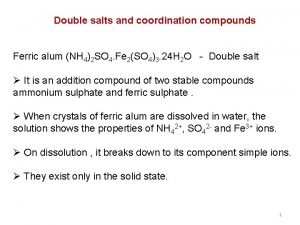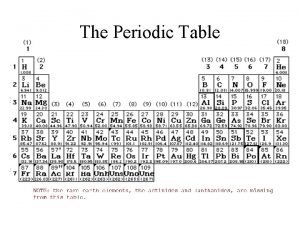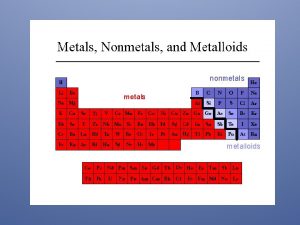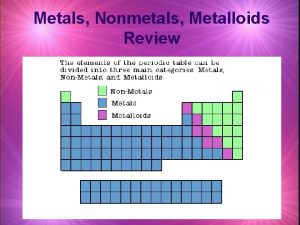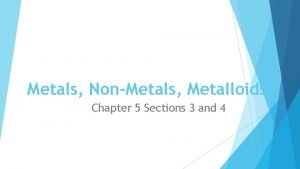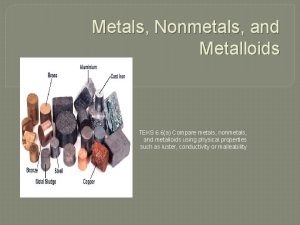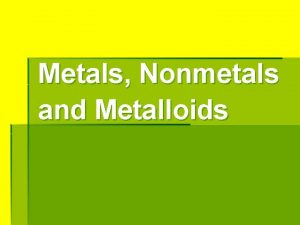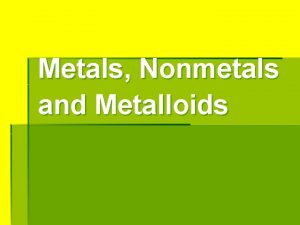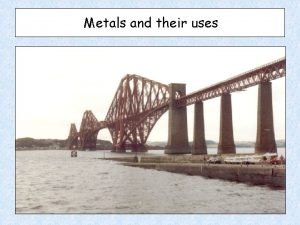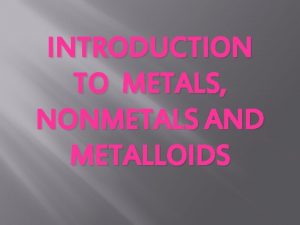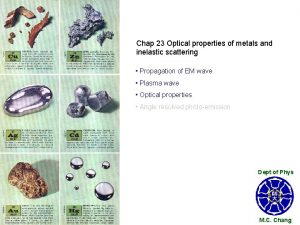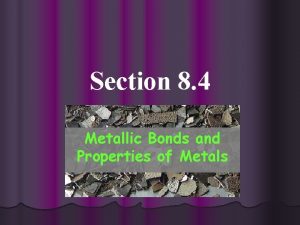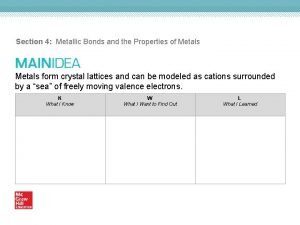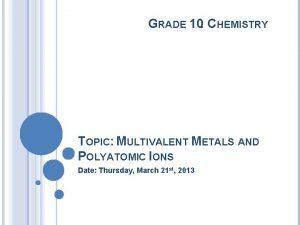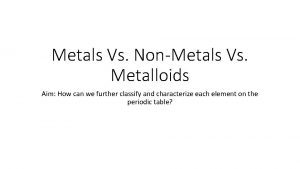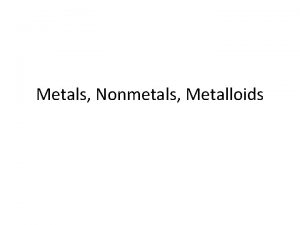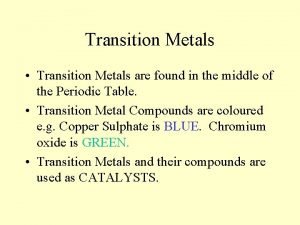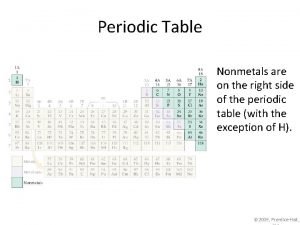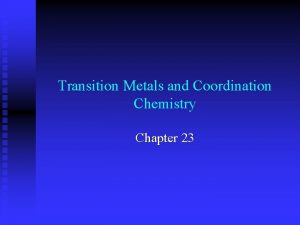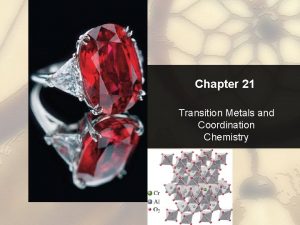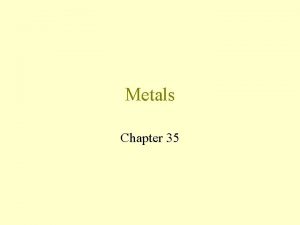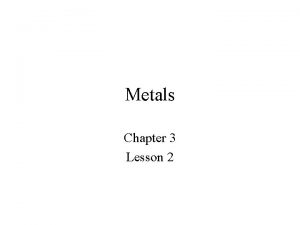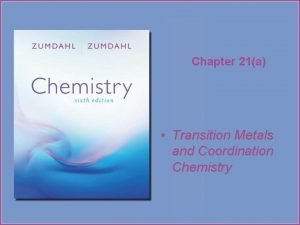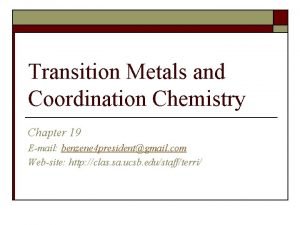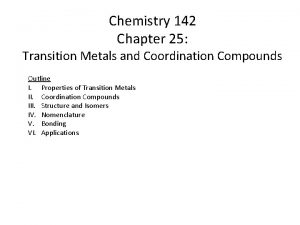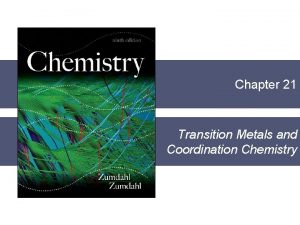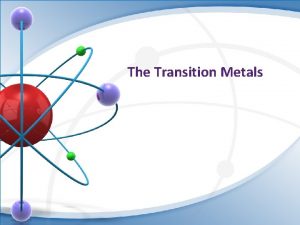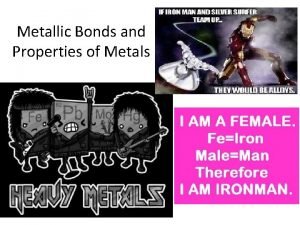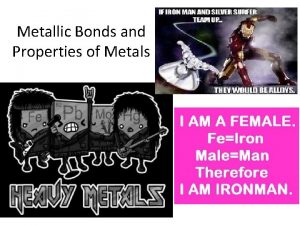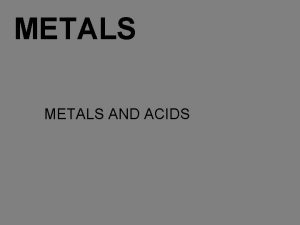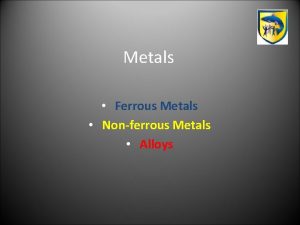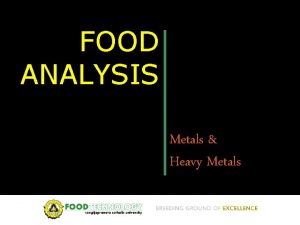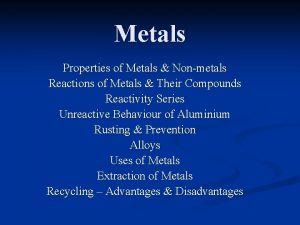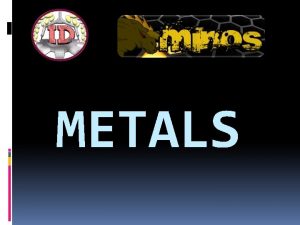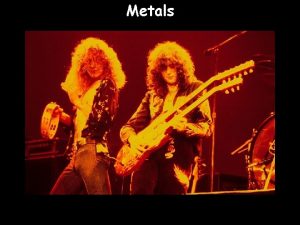Transition Metals and Coordination Chemistry Chapter 23 Transition




















![Coordination Compound Consist of a complex ion and necessary counter ions [Co(NH 3)5 Cl]Cl Coordination Compound Consist of a complex ion and necessary counter ions [Co(NH 3)5 Cl]Cl](https://slidetodoc.com/presentation_image/4a1ee8012f8481e97357305a4b6c4698/image-21.jpg)
![[Co(NH 3)6]Cl 3 [Pt(NH 3)4]Br 2 Complex ion remains intact upon dissolution in water [Co(NH 3)6]Cl 3 [Pt(NH 3)4]Br 2 Complex ion remains intact upon dissolution in water](https://slidetodoc.com/presentation_image/4a1ee8012f8481e97357305a4b6c4698/image-22.jpg)









![Examples K 2[Co(NH 3)2 Cl 4] potassium diamminetetrachlorocobaltate(II) [Co(NH 3)4 Cl 2]Cl tetraamminedichlorocobalt(III) chloride Examples K 2[Co(NH 3)2 Cl 4] potassium diamminetetrachlorocobaltate(II) [Co(NH 3)4 Cl 2]Cl tetraamminedichlorocobalt(III) chloride](https://slidetodoc.com/presentation_image/4a1ee8012f8481e97357305a4b6c4698/image-32.jpg)





![Linkage Isomers [Co(NH 3)5(NO 2)]Cl 2 Pentaamminenitrocobalt(III) chloride [Co(NH 3)5(ONO)]Cl 2 Pentaamminenitritocobalt(III) chloride Linkage Isomers [Co(NH 3)5(NO 2)]Cl 2 Pentaamminenitrocobalt(III) chloride [Co(NH 3)5(ONO)]Cl 2 Pentaamminenitritocobalt(III) chloride](https://slidetodoc.com/presentation_image/4a1ee8012f8481e97357305a4b6c4698/image-38.jpg)



















![[V(H 2 O)6]2+ [V(H 2 O)6]3+ [Cr(NH 3)5 Cl]2+s [V(H 2 O)6]2+ [V(H 2 O)6]3+ [Cr(NH 3)5 Cl]2+s](https://slidetodoc.com/presentation_image/4a1ee8012f8481e97357305a4b6c4698/image-58.jpg)









- Slides: 67

Transition Metals and Coordination Chemistry Chapter 23

Transition Metals Similarities within a given period and within a given group. Last electrons added are inner electrons (d’s, f’s).









Multiple Oxidation States

Metallic Behavior/Reducing Strength Lower oxidation state = more metallic

Color and Magnetism e- in partially filled d sublevel absorbs visible light moves to slightly higher energy d orbital Magnetic properties due to unpaired electrons

Electronegativity increases down column

Chromium Chemical properties reflect oxidation state

Valence-State Electronegativity, EN: electron “pulling power” Valence-state EN: metal in higher oxidation state is more positive has stronger pull on electrons is more electronegative “Effective EN”

Manganese

Silver

Weak Reducing Agent, H 2 Q

Mercury
![Coordination Compound Consist of a complex ion and necessary counter ions CoNH 35 ClCl Coordination Compound Consist of a complex ion and necessary counter ions [Co(NH 3)5 Cl]Cl](https://slidetodoc.com/presentation_image/4a1ee8012f8481e97357305a4b6c4698/image-21.jpg)
Coordination Compound Consist of a complex ion and necessary counter ions [Co(NH 3)5 Cl]Cl 2 Complex ion: [Co(NH 3)5 Cl]2+ Co 3+ + 5 NH 3 + Cl= 1(3+) + 5 (0) + 1(1 -) = 2+ Counter ions: 2 Cl-
![CoNH 36Cl 3 PtNH 34Br 2 Complex ion remains intact upon dissolution in water [Co(NH 3)6]Cl 3 [Pt(NH 3)4]Br 2 Complex ion remains intact upon dissolution in water](https://slidetodoc.com/presentation_image/4a1ee8012f8481e97357305a4b6c4698/image-22.jpg)
[Co(NH 3)6]Cl 3 [Pt(NH 3)4]Br 2 Complex ion remains intact upon dissolution in water

Complex Ion Species where transition metal ion is surrounded by a certain number of ligands. Transition metal ion: Ligands: Lewis acid Lewis bases Co(NH 3)63+ Pt(NH 3)3 Br+


Ligands Molecule or ion having a lone electron pair that can be used to form a bond to a metal ion (Lewis base). coordinate covalent bond: metal-ligand bond monodentate: bidentate: polydentate: one bond to metal ion two bond to metal ion more than two bonds to a metal ion possible



Formulas of Coordination Compounds 1. Cation then anion 2. Total charges must balance to zero 3. Complex ion in brackets K 2[Co(NH 3)2 Cl 4] [Co(NH 3)4 Cl 2]Cl

Names of Coordination Compounds 1. Cation then anion 2. Ligands in alphabetical order before metal ion neutral: molecule name* anionic: -ide -o prefix indicates number of each 3. Oxidation state of metal ion in () only if more than one possible 4. If complex ion = anion, metal ending -ate


![Examples K 2CoNH 32 Cl 4 potassium diamminetetrachlorocobaltateII CoNH 34 Cl 2Cl tetraamminedichlorocobaltIII chloride Examples K 2[Co(NH 3)2 Cl 4] potassium diamminetetrachlorocobaltate(II) [Co(NH 3)4 Cl 2]Cl tetraamminedichlorocobalt(III) chloride](https://slidetodoc.com/presentation_image/4a1ee8012f8481e97357305a4b6c4698/image-32.jpg)
Examples K 2[Co(NH 3)2 Cl 4] potassium diamminetetrachlorocobaltate(II) [Co(NH 3)4 Cl 2]Cl tetraamminedichlorocobalt(III) chloride




Structural Isomerism 1 Coordination isomerism: Composition of the complex ion varies. [Cr(NH 3)5 SO 4]Br and [Cr(NH 3)5 Br]SO 4

Structural Isomerism 2 Ligand isomerism: Same complex ion structure but point of attachment of at least one of the ligands differs. [Co(NH 3)4(NO 2)Cl]Cl and [Co(NH 3)4(ONO)Cl]Cl
![Linkage Isomers CoNH 35NO 2Cl 2 PentaamminenitrocobaltIII chloride CoNH 35ONOCl 2 PentaamminenitritocobaltIII chloride Linkage Isomers [Co(NH 3)5(NO 2)]Cl 2 Pentaamminenitrocobalt(III) chloride [Co(NH 3)5(ONO)]Cl 2 Pentaamminenitritocobalt(III) chloride](https://slidetodoc.com/presentation_image/4a1ee8012f8481e97357305a4b6c4698/image-38.jpg)
Linkage Isomers [Co(NH 3)5(NO 2)]Cl 2 Pentaamminenitrocobalt(III) chloride [Co(NH 3)5(ONO)]Cl 2 Pentaamminenitritocobalt(III) chloride

Stereoisomerism 1 Geometric isomerism (cis-trans): Atoms or groups arranged differently spatially relative to metal ion Pt(NH 3)2 Cl 2



Stereoisomerism 2 Optical isomerism: Have opposite effects on plane-polarized light (no superimposable mirror images)








Crystal Field Theory Focus: energies of the d orbitals Assumptions 1. Ligands: 2. Metal-ligand bonding: negative point charges entirely ionic strong-field (low-spin): large splitting of d orbitals weak-field (high-spin): small splitting of d orbitals



D = crystal field splitting

High spin Low spin



![VH 2 O62 VH 2 O63 CrNH 35 Cl2s [V(H 2 O)6]2+ [V(H 2 O)6]3+ [Cr(NH 3)5 Cl]2+s](https://slidetodoc.com/presentation_image/4a1ee8012f8481e97357305a4b6c4698/image-58.jpg)
[V(H 2 O)6]2+ [V(H 2 O)6]3+ [Cr(NH 3)5 Cl]2+s




Tetrahedral Complexes


Square Planar & Linear Complexes Approach along x-and y-axes Approach along z-axis



Hemoglobin & Oxyhemoglobin
 Metals nonmetals and metalloids periodic table
Metals nonmetals and metalloids periodic table Physical properties of metals
Physical properties of metals Natural science grade 7 term 4 notes
Natural science grade 7 term 4 notes Natural science grade 7 lesson plans term 2
Natural science grade 7 lesson plans term 2 Example of metal
Example of metal Ligand isomerism
Ligand isomerism Ferrous metals vs non ferrous metals
Ferrous metals vs non ferrous metals Properties of ionic bonds
Properties of ionic bonds 7 ionic and metallic bonding practice problems
7 ionic and metallic bonding practice problems Electronic spectra of coordination compounds
Electronic spectra of coordination compounds Correlation diagram in coordination chemistry
Correlation diagram in coordination chemistry Coordination number
Coordination number Ga valence electrons
Ga valence electrons Elements with 7 valence electrons
Elements with 7 valence electrons Whats ionic bonding
Whats ionic bonding Elements and their properties
Elements and their properties Electron configuration of transition metals
Electron configuration of transition metals Biological importance of transition metals
Biological importance of transition metals Inner transition metals definition
Inner transition metals definition Are all transition metals multivalent
Are all transition metals multivalent Transition metals ionization energy
Transition metals ionization energy Ionic compounds containing transition metals
Ionic compounds containing transition metals Knockhardy a level chemistry
Knockhardy a level chemistry Transition metals display great similarities
Transition metals display great similarities Chapter 7 ionic compounds and metals
Chapter 7 ionic compounds and metals Chapter 7 ionic compounds and metals assessment answer key
Chapter 7 ionic compounds and metals assessment answer key Chapter 4 metals and nonmetals
Chapter 4 metals and nonmetals Transition state diagram chemistry
Transition state diagram chemistry Ib chemistry organic chemistry
Ib chemistry organic chemistry Organic vs inorganic chemistry
Organic vs inorganic chemistry Mac group nims
Mac group nims How do coordination structures help
How do coordination structures help Outline what is
Outline what is Lamport
Lamport Non equilibrium coordination test
Non equilibrium coordination test Control and coordination in management
Control and coordination in management Main clause vs subordinate clause
Main clause vs subordinate clause Nghp oklahoma city
Nghp oklahoma city Maryland coordination and analysis center
Maryland coordination and analysis center Fish and wildlife coordination act
Fish and wildlife coordination act Coordination and maintenance committee
Coordination and maintenance committee Nims command
Nims command What is coordination and subordination
What is coordination and subordination Double salts and coordination compounds
Double salts and coordination compounds What is balance and coordination
What is balance and coordination Periodic table metals nonmetals semimetals
Periodic table metals nonmetals semimetals Periodic table separating metals and nonmetals
Periodic table separating metals and nonmetals I am malleable, but i do not have a shiny luster.
I am malleable, but i do not have a shiny luster. Bulletproof metal periodic table
Bulletproof metal periodic table The physical properties of metals include luster and
The physical properties of metals include luster and Metals nonmetals and metalloids
Metals nonmetals and metalloids Compare metals nonmetals and metalloids
Compare metals nonmetals and metalloids Difference between metals nonmetals and metalloids
Difference between metals nonmetals and metalloids Periodic table metals nonmetals and metalloids color
Periodic table metals nonmetals and metalloids color Melting point of diamond
Melting point of diamond Brass vs bronze
Brass vs bronze Properties of metals nonmetals and semimetals
Properties of metals nonmetals and semimetals Metals used
Metals used Elements and their properties section 1 metals answer key
Elements and their properties section 1 metals answer key Optical properties of metals and nonmetals
Optical properties of metals and nonmetals Reactivity of alkali earth metals
Reactivity of alkali earth metals Section 4 metallic bonds and the properties of metals
Section 4 metallic bonds and the properties of metals Section 4 metallic bonds and the properties of metals
Section 4 metallic bonds and the properties of metals List of multivalent metals
List of multivalent metals Metals vs metalloids and nonmetals
Metals vs metalloids and nonmetals Periodic table divided in metals nonmetals and metalloids
Periodic table divided in metals nonmetals and metalloids Poem about metals nonmetals and metalloids
Poem about metals nonmetals and metalloids What is a nonmetal element
What is a nonmetal element









